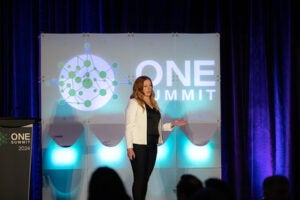This post was originally published on the CPaaS Acceleration Alliance blog and is written by Rob Kruver, CPaaS Acceleration Alliance Founding Partner
 Held at the San Jose McEnery Convention Center from April 30th to May 1st, the ONE Summit organized by the Linux Foundation brought together over 400 professionals from across the globe to discuss Open Networks.
Held at the San Jose McEnery Convention Center from April 30th to May 1st, the ONE Summit organized by the Linux Foundation brought together over 400 professionals from across the globe to discuss Open Networks.
This pivotal event highlighted the transformation from closed, proprietary systems to open-source frameworks that enhance security and foster innovation, setting the stage for a comprehensive discussion on the future of telecommunications. ONE went from a great idea 6 years ago to (almost) complete open networks that are commercially deployed today, and can unlock great new value through APIs.
AI and the Future of Network Design
Artificial Intelligence (AI) is redefining network architecture, introducing capabilities that were once the stuff of science fiction—autonomous, self-healing, and self-optimizing networks. Google Cloud’s Ankur Jain presented a compelling demonstration that made sophisticated AI applications appear deceptively simple, emphasizing the need for advanced AI competencies in the industry.
Dr. Junlan Feng from China Mobile also presented their developments in Large Language Models (LLMs), necessary for managing the complexities of the world’s largest network. These talks illustrated the critical role AI is playing in evolving network infrastructure and highlighted the growing skills gap that must be addressed.
Broadband as a Utility
Arun Bhikshesvaran, CEO of Radisys, passionately argued for viewing broadband as a fundamental utility, essential for everyone, everywhere—similar to water or electricity. His presentation resonated with the audience, reinforcing the idea that reliable internet access should be universally available, underscoring its importance to modern society.
Changing Market Dynamics and The Human Element
The opening panel, featuring luminaries like Jan Uddenfeldt, former CTO of Ericsson, and Radia Perlman, inventor of the spanning tree protocol, covered a range of topics from the impact of AI on networking to the importance of maintaining a human-centric approach in technological advancements. Their discussions emphasized that while technology is advancing rapidly, the human element remains crucial to its successful integration and acceptance.
The Critical Role of Edge Computing
Walmart and Rockwell Automation presented their extensive use of edge computing, showcasing how this technology enables robust, fault-tolerant networks capable of operating independently from centralized sources. These real-world applications demonstrate the importance of edge computing in creating efficient, scalable network infrastructures that can support a range of industrial and consumer applications.
Industry Embrace of Open and Programmable Networks
The landscape of networking is increasingly characterized by openness and collaboration, underscored by the commercial deployment of Open RAN (O-RAN). Companies like Rakuten, T-Mobile, and Vodafone are leading the way in adopting these open architectures. Alex Choi of Deutsche Telekom highlighted the adoption of O-RAN by 32 operators, showcasing a widespread industry shift towards networks that promote security, foster innovation, and prevent costly vendor lock-ins.
Additionally, the announcement of a new partnership between Nokia and Infobip, which came on May 2nd, right after the Summit, highlights the growing trend of collaborations between network technology providers and CPaaS entities. This partnership underscores the commitment to enhancing network capabilities and service offerings through strategic alliances.
Open Networks are Key to Monetization and Value Creation
One of the Summit’s most pivotal presentations was delivered by Alicia Miller, who serves as the Strategy Development and Execution | Network API Ecosystem Development Lead at Verizon. Introduced by Arpit Joshipura, head of the Linux Foundation’s Open Network efforts, as delivering “the most important talk of the event, because there is gold in the network,” Miller’s discussion focused on Project CAMARA and the crucial need for the global mobile industry to rapidly adopt these APIs. (You can watch Alicia’s keynote presentation here.)
CAMARA, a joint effort by the Linux Foundation and GSMA as part of their Open Gateway Initiative, includes 18 APIs spread across six categories. Miller emphasized that these APIs are the key to unlocking the network’s full economic potential, advocating for their adoption as a pathway to not only enhance operational efficiencies but also generate significant revenue opportunities across the telecommunications sector.
Advocating for Network API Standardization and Collaboration
The CPaaS Acceleration Alliance is spearheading efforts to promote standardized, open network APIs. The upcoming Service Provider Playbook will showcase over 50 real API/CPaaS use cases from its members, demonstrating practical applications and the benefits of these technologies. Additionally, the CASA24 event in Amsterdam will provide a platform for further discussion and collaboration on network APIs, highlighting their transformative potential.
Conclusion
The ONE Summit was a beacon for the future of telecommunications, emphasizing the indispensable roles of open networks, AI, edge computing, and APIs in shaping the industry. The CPaaS Acceleration Alliance is poised to play a pivotal role in the standardization and widespread adoption of these technologies, driving progress and creating new opportunities across the sector.
We invite all network operators and technology companies to join us at CASA24, September 16-18 in Amsterdam, where we will dedicate a full day to exploring network APIs and their potential to revolutionize telecommunications.
